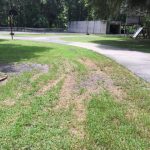
Lawn Diseases 101
Article by: Jessica Warren, ANR Agent, Camden County


One of the most common issues that I receive questions about throughout the year is suspected lawn disease. Though there are several diseases that affect turfgrass in Georgia, often there is an abiotic source of the issue. Even if there is a disease present, the first step in controlling it is correcting the environmental issue behind it. Chemical treatments and fungicides will not be effective unless the environmental issue is corrected first.
Disease cannot occur without a conducive environment and many times human mismanagement is the cause of that conducive environment. Think of disease as a triangle or a Venn diagram. There are three factors that must occur in tandem for disease to occur – the pathogen, a susceptible host, and a conducive environment. If any one of these factors isn’t present, disease won’t occur. Pathogens are always in the environment naturally. The other two factors are the ones that we have some control over. It’s important to plant disease resistant varieties when possible. Keep in mind that disease resistant does not mean disease proof. In a poor environment with a pathogen, these varieties can still fall victim. Though we have limited control over the environment, many of the environmental issues I see are human caused. If disease is present, it can’t be corrected or treated without first correcting the environmental issue. Most often this issue is overwatering. Since the diseases that we see in Georgia are fungal, it makes sense that they need a wet environment to take hold. All turf diseases are not the same, but they all have a lot of similarities – especially when it comes to prevention and treatment.
The most important tool in the prevention of disease is proper lawn management. Incorrect mowing, watering and/or fertilizing can lead to symptoms that have the appearance of disease, as well as increase susceptibility to disease. Best management practices vary depending on the species of grass that you have, but some general rules follow. Only mow 1/3 of the leaf blade at a time. If adding supplemental water it is better to water less often and deeper – a maximum of about 1 inch per week including rainfall (much less in the winter when the grass is dormant). Honestly, I see less problems in our area with lawns that aren’t irrigated at all. Conduct a soil test ($7 through our office) before applying fertilizer. A soil test will tell you your nutrient levels, pH level, if fertilizer is needed – and if so – what kind and how much. And no, the at home kits from the big box stores are not the same. I see people spend a lot of money and create a lot of pollution to our waterways by applying fertilizer that is not needed. You should never apply lime without a soil test that tells you to do so. Lime only serves to increase the pH level of the soil. Typically, our soil naturally has a high (often too high for turfgrass) pH. Some diseases such as take all root rot, only become an issue at too high of a pH. Soil pH levels also affect the ability of the plant to take in the nutrients in the soil. Also keep in mind that fertilizer and pesticides can cause as much harm as they can good if applied inappropriately or to the wrong species of grass.
If you suspect disease, we can submit a pathology sample to the lab for $14. Instructions can be found on our website. I will tell you, however, that in nine years I have only seen maybe ten percent of pathology samples from this county come back positive for disease. All the rest come back as abiotic/environmental issue/too much moisture.